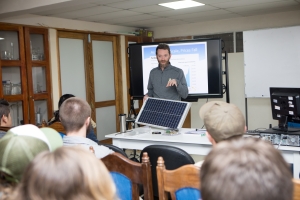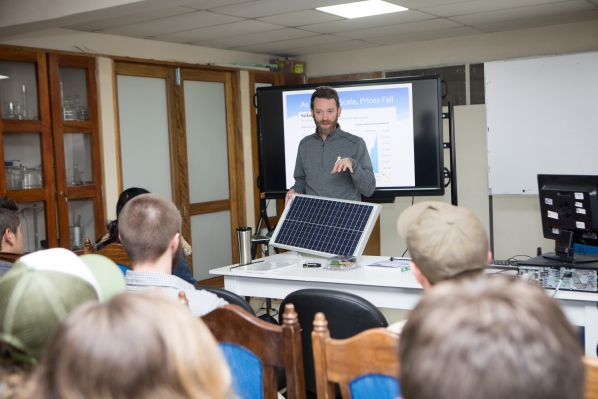In June 2018, 14 Appalachian State University students packed their bags and boarded a plane to Peru to spend almost three weeks studying and implementing renewable energy solutions in remote areas of the country. The students designed and built photovoltaic (PV or solar-powered) systems, investigated wind and hydroelectric resources and conducted a needs assessment for future energy projects.
The group, led by assistant professor Dr. Jeremy Ferrell and Practitioner-in-Residence Brent Summerville in the Department of Sustainable Technology and the Built Enviornment, first stopped at the University of San Antonio de Abad of Cusco (UNSAAC), where they conducted a two-day workshop with professor of physics Dr. Julio Wharton and his students. They worked together to build two small-scale PV systems to bring light and power to remote areas of the country.
According to Summerville, the group met on campus before leaving Boone to prototype the PV system, which allowed them to plan ahead and bring tools and parts they might need.
“We had to improvise a bit, which is common [when building renewable energy systems] in the developing world,” Ferrell added. “We found the 12-volt LED light we needed at an auto parts store in Cusco.”
The group then met up with Dr. Baker Perry, professor of geography at Appalachian, who led a study abroad course to Peru to investigate theeffects of climate change on dynamic tropical glaciers. Ferrell, Summerville and Baker, along with their students, first collaborated on a wind energy assessment near the Incan village of Ollantaytambo and then performed a community needs assessment in the rural village of Pucarumi at the base of the Ausangate glacier.
Ferrell said that the experience collaborating with Perry and his students provided an opportunity to learn from each other about why they are all managing various projects on the other side of the globe.
“While reading out data during the assessment, we determined the average wind speed and direction was sufficient for wind energy development,” he shared. “Baker immediately recognized that this information verified what he, too, was observing in explaining the climate of this rugged region.”
The jointly conducted needs assessment in Pucarumi may inform future travel to the region as well. According the Ferrell, the group installed one of the PV systems they built with Wharton and his students in the village, and he is interested in leading a trip back to the region to install additional renewable energy systems.
Ferrell noted that while logistically challenging, the interdisciplinary collaboration holds potential for both students and faculty. Summerville agreed, and recognized the added value of participating in a study abroad experience.
“These trips result in a strong bond between the students and faculty that can't be replicated in the classroom,” he said. “Not only did Jeremy and I benefit from the collaboration, our students enjoyed working alongside the UNSAAC students in the hands-on solar workshop that we conducted as well.”
About the Department of Sustainable Technology and the Built Environment
One of seven departments housed in the College of Fine and Applied Arts, the Department of Sustainable Technology and the Built Environmentat Appalachian State University features an integrated array of programs spanning the fields of sustainable design and technology. Its mission is to foster a strong and vibrant culture of inquiry, discovery and innovation that integrates theory with application, problem seeking with problem-solving, local issues with global perspectives and technological progress with environmental stewardship. It offers bachelor’s degrees in sustainable technology and building science, and a master’s degree in technology.
About Appalachian State University
Appalachian State University, in North Carolina’s Blue Ridge Mountains, prepares students to lead purposeful lives as global citizens who understand and engage their responsibilities in creating a sustainable future for all. The transformational Appalachian experience promotes a spirit of inclusion that brings people together in inspiring ways to acquire and create knowledge, to grow holistically, to act with passion and determination, and embrace diversity and difference. As one of 17 campuses in the University of North Carolina system, Appalachian enrolls about 19,000 students, has a low student-to-faculty ratio and offers more than 150 undergraduate and graduate majors.

